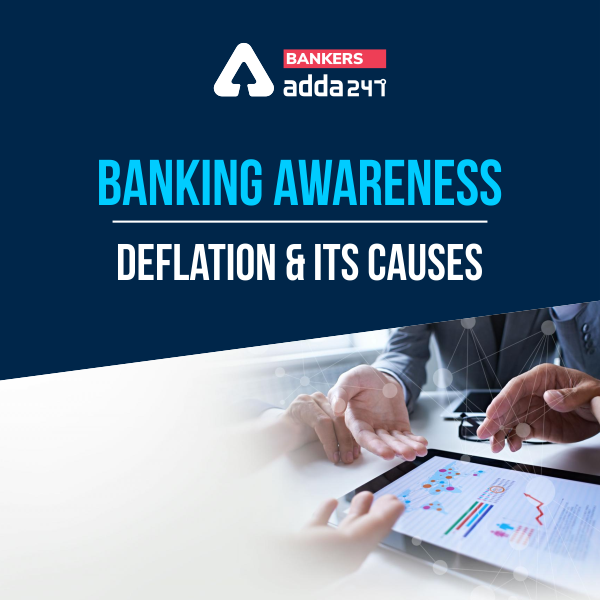Banking awareness is an important topic in General Awareness section and usually a lot of questions are asked from this topic. A banking aspirant is expected to know the basic terms related to banking. This topic will also help you to ace your interview as well. Deflation is one of the common topic of banking awarness and hence we will be covering it in detail in this article.
Also check,
| What is MCLR? | Bank Cheques: Different Types of Cheques and its features | What Are NBFC And Their Functions |
What Is Deflation?
Deflation is a phenomenon that is opposite of inflation. Just like inflation is a phenomenon of rising prices, deflation refers to a phenomenon of falling prices. In the words of Crowther, “Deflation is that state of the economy where the value of money is rising or the prices are falling.” Though deflation is associated with falling prices, but it is not that each and every fall in price will be termed as deflation.
We categorized only those falls in prices which result in unemployment, overproduction and fall in the economic activity as deflationary. In other words, deflation is a situation in which falling prices are accompanied by falling levels of employment, output and income.
Also Read,
Causes of Deflation:
Deflation is a condition in which falling prices are accompanied by falling levels of employment, income and output. Deflation can be due to certain natural causes, or it can be due to a deliberate policy of the government.
The following are the important causes of deflation:
1. Keynes’ Explanation:
Keynes had given a systematic theory to explain the phenomenon of deflation (or depression).
(i) Deficient Aggregate Demand:
One of the major reason for deflation is the deficiency of aggregate demand which leads to over-production and unemployment. Aggregate demand consists of aggregate consumption expenditure and aggregate investment expenditure.
Also Read,
| SBI PO 2020: Preparation Tips, Strategy, & Study Plan | Best Approach Towards Solving Error Detection In Banking Exam | How to Target SBI PO 2020 |
(ii) Less Investment Expenditure:
Private investment is basically governed by the marginal efficiency of capital (MEC) and rate of interest. The phenomenon of Deflation is the result of decline in investment which is due to (a) low MEC or low profitability of capital and (b) high rate of interest.
(iii) Fall in MEC:
Another reason is the economic expansion because the process of economic expansion goes on, certain forces come into operation which exerts downward pressures on MEC.
These forces can be categorized as:
(a) While the process of expansion is taking place, costs of production start rising on account of the increasing scarcities of materials and equipment. The cost of Wage also rises because of scarcity of labour and rising costs have the depressing effect on MEC.
(b)The Increase in the abundance of output resulting from industrial expansion leads to lessen the returns below expectations which also depress MEC.
(iv) Less Consumption:
One of the basic cause of deflation or depression lies in Keynes’ concept of consumption function or his psychological law of consumption. As per the law, the consumers do not spend the whole of the increment of their incomes on consumer goods.
As the income of a person increases, the person spends a smaller proportion of its increased income on consumer goods. The reduction in sale of consumer goods leads to the accumulation of stock of consumer goods (or overproduction). This also has adverse effect on business expectations and MEC.
(v) Rise in Rate of Interest:
Another reason is the fall in the MEC which is followed by a rise in demand for money or rise in liquidity preference (i.e., the tendency of the people to keep money in cash form). No one likes to purchase goods or securities when the prices of the commodities are falling. Given that the supply of money, increase in liquidity preference results in the rise in the rate of interest which also reduces investment.
To sum up all of the facts , according to Keynes, rising rate of interest, declining MEC, falling tendency of consumption- all these factors lead to reduce aggregate demand which ultimately result in deflationary conditions in the economy.
Also read,
| How To Manage Mental Stress During Lockdown? | Share Your Success Story And Inspire Others | Lockdown 2.0 – What are Red, Orange and Green Zones? |
2. Contractionary Monetary Policy:
It is a situation when the government adopts a contractionary monetary policy, it makes the availability of credit more costly by raising the rate of interest and reducing the supply of money which results in fall in prices. There are Various contractionary monetary measures are- raising the bank rate, sale of government securities, raising the cash reserve ratio, reducing the currency, etc.
3. Reduction in Government Expenditure:
If the government decides to reduce public expenditure, it will also reduce national income and employment multiple times (through the adverse working of multiplier) which will reduce aggregate demand, discourage investment and affect the economic activity of the economy adversely.
4. Heavy Taxes:
This is another factor, Heavy taxes imposed by the government reduce the disposable income with the people which leads to the decline in both consumption and investment expenditure and results in deflationary conditions.
5. Increasing Economic Inequalities:
Due to the Increase in inequalities of income and wealth make the rich more rich and the poor more poor. Because the marginal propensity to consume (MPC) of the rich is less than that of the poor, growing inequalities of income will reduce consumption expenditure and will lead to deflationary situation.



 Weekly Current Affairs One Liners 23rd t...
Weekly Current Affairs One Liners 23rd t...
 CSIR CRRI Typing Test 2025 Date for JSA ...
CSIR CRRI Typing Test 2025 Date for JSA ...
 Can Final Year Students Apply for SBI PO...
Can Final Year Students Apply for SBI PO...


